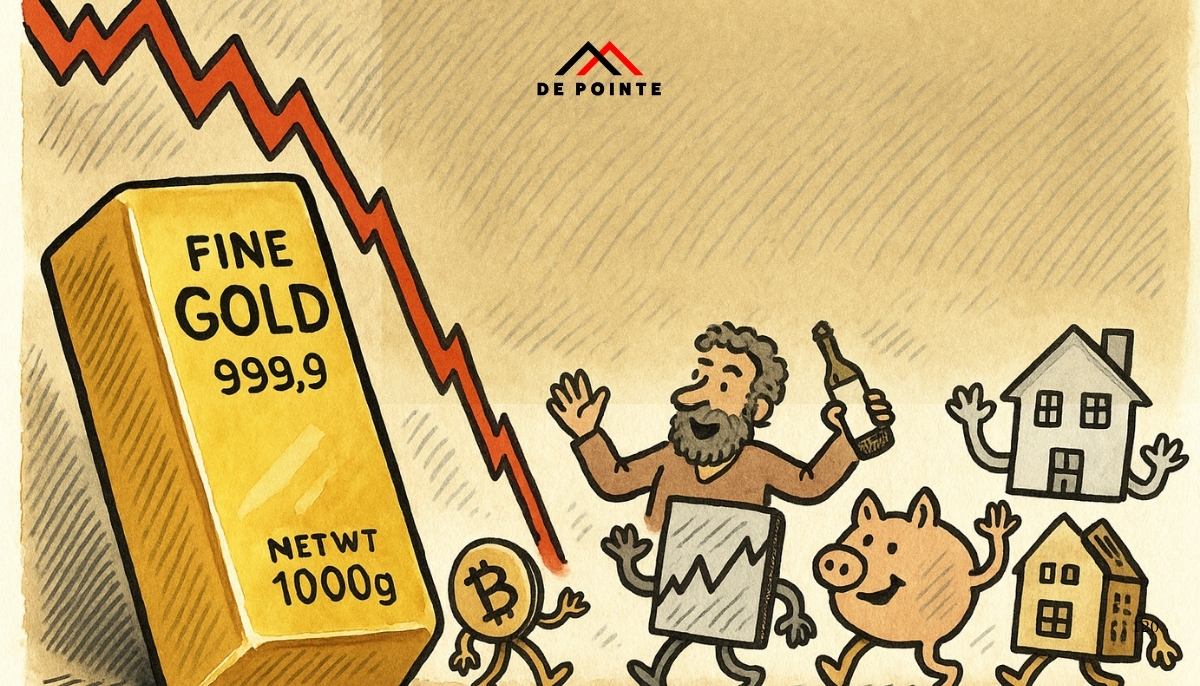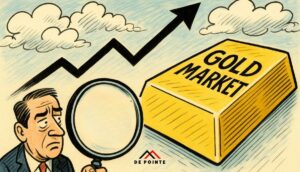Article

When gold prices fall, many investors instinctively worry about portfolio stability. For decades, gold has been considered a safe-haven asset—a store of value during economic uncertainty. However, like any asset, gold is not immune to market fluctuations. Over the last year, gold surged to historic highs, climbing from around $2,064 per ounce in January 2024 to $3,395 in August 2025, a staggering 64% jump. Now, analysts are signalling that the rally may be cooling, driven by factors such as easing inflation, a stronger US dollar, and reduced geopolitical tensions.
At De Pointe Research, we see moments like this not as setbacks, but as opportunities. If gold is starting to lose momentum, diversifying into other asset classes can help protect and even enhance returns. Here are five alternative investments to explore when gold prices fall.
1. Fine Art Investment
Art is more than a decorative luxury; it’s an established alternative asset class with strong historical performance. The Knight Frank Luxury Investment Index ranked art as the top performer in terms of 1-year capital gains in 2023, delivering an 11% return, and an extraordinary 29% in 2022. Unlike gold, fine art’s value is often driven by cultural relevance, artist reputation, and scarcity rather than macroeconomic trends alone.
Investors benefit from:
- Low correlation with stock markets – making art a valuable hedge
- Strong historical appreciation – particularly for artists represented in museum collections
- Tangible asset appeal – unlike digital or paper investments, art can be enjoyed while it appreciates
When gold prices fall, reallocating a portion of capital into blue-chip or museum-grade contemporary art can provide long-term growth and portfolio resilience.
2. Real Estate and Infrastructure
Property remains a cornerstone of wealth preservation, offering rental income alongside capital appreciation. Even when financial markets dip, real estate often maintains stability due to the underlying demand for housing and commercial spaces. Infrastructure projects, such as renewable energy facilities, transport hubs, and utilities, also provide steady, often inflation-linked cash flows.
Advantages include:
- Passive income from rents or infrastructure dividends
- Inflation protection through rising property values and adjusted contracts
- Global diversification by investing in different geographies and sectors
When gold prices fall, investors can pivot into these hard assets to balance income generation with long-term capital preservation.
3. Private Credit and Fixed Income
Bonds and private credit have been making a comeback. While public fixed income markets offer predictable yields, private credit markets provide opportunities for higher returns by lending directly to businesses. These investments are often secured by collateral, providing additional downside protection.
Key benefits:
- Consistent income from interest payments
- Lower volatility compared to equities
- Diversification into debt instruments not tied to gold or commodity cycles
In periods when gold prices fall, these steady income-producing assets can help offset short-term portfolio dips.
4. Hedge Funds and Specialist Strategies
Hedge funds, especially those pursuing market-neutral or arbitrage strategies, aim to generate positive returns regardless of market direction. Some funds specialise in distressed assets, commodities (other than gold), or volatility trading, tapping into market inefficiencies.
Potential benefits:
- Absolute return potential in various market conditions
- Access to niche opportunities outside mainstream equities or commodities
- Professional management with sophisticated risk controls
For investors willing to commit capital for a longer term, these strategies can deliver uncorrelated returns, making them a helpful option when gold prices fall.
5. Silver and Other Precious Metals
If you still want precious metal exposure but are concerned about gold’s current trajectory, silver, platinum, and palladium offer alternatives. Silver is often more volatile than gold, meaning it can offer greater upside potential in a recovery. Platinum and palladium, meanwhile, are heavily used in industrial applications, providing demand drivers outside traditional investment markets.
Why consider them?
- Industrial demand supports pricing even when investment sentiment weakens
- Different supply dynamics than gold
- Potential for rapid rebounds when market sentiment shifts
When gold prices fall, reallocating some holdings to other precious metals can preserve exposure to commodities without relying solely on gold’s performance.
Why Diversification Matters When Gold Prices Fall
Periods of gold weakness are a reminder that no single asset should dominate a portfolio. A balanced allocation across multiple asset classes reduces overall volatility and can enhance long-term returns. Diversification is not just about avoiding losses; it’s about capturing opportunities in other sectors when one asset class underperforms.
At De Pointe Research, our analysis shows that investors with a well-structured mix of tangible and financial assets tend to outperform those relying heavily on a single category. When gold prices fall, this diversified approach allows investors to redeploy capital strategically into other assets poised for growth.
Taking Action
If you’re concerned about the recent decline in gold prices, now is the time to review your portfolio. Consider the following steps:
- Assess your current allocation to gold and other commodities
- Identify gaps in your exposure to tangible, income-producing, and growth-oriented assets
- Research top-performing alternatives in line with your risk profile
- Consult with a specialist to ensure proper due diligence before investing
Gold remains an integral part of many portfolios, but its price movements should guide, not dictate, your investment strategy. When gold prices fall, well-prepared investors see it as a signal to explore other avenues. Whether it’s fine art, real estate, private credit, specialist funds, or other precious metals, opportunities abound for those ready to diversify.
At De Pointe Research, we specialise in sourcing and evaluating these alternative investments, helping you create a portfolio built to weather market shifts and deliver sustainable long-term growth.






